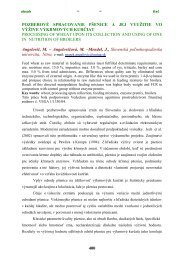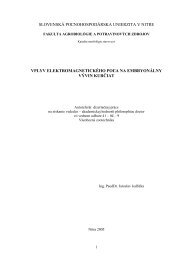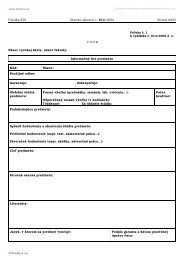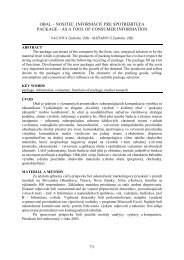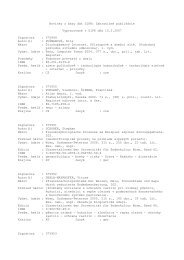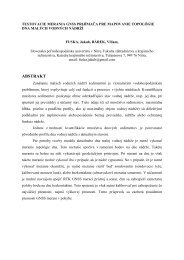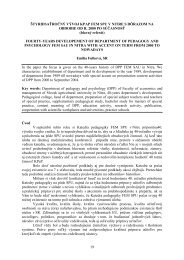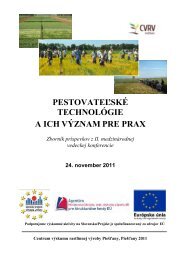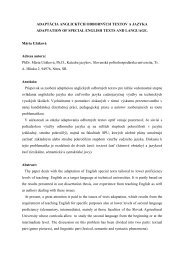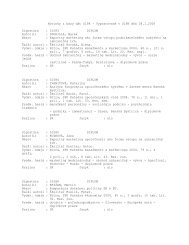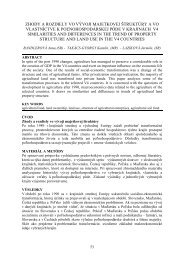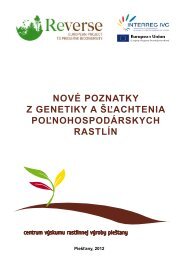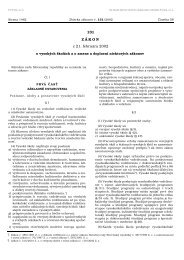Acta fytotechnica et zootechnica, Vol. 4, 2001, Special Number ...
Acta fytotechnica et zootechnica, Vol. 4, 2001, Special Number ...
Acta fytotechnica et zootechnica, Vol. 4, 2001, Special Number ...
You also want an ePaper? Increase the reach of your titles
YUMPU automatically turns print PDFs into web optimized ePapers that Google loves.
<strong>Acta</strong> <strong>fytotechnica</strong> <strong>et</strong> <strong>zootechnica</strong>, <strong>Vol</strong>. 4, <strong>2001</strong>, <strong>Special</strong> <strong>Number</strong><br />
Proceedings of the International Scientific Conference on the Occasion of the 55 th Anniversary of the Slovak Agricultural<br />
University in Nitra<br />
reached 10.46 t and in the second 10.63 t · ha -1 . In comparison with the control the increase was about 80% and by 25% in<br />
comparison to farmyard manure treatment.<br />
Table 1. Yields of dry mass<br />
Treatment 1998 1999 2000 Mean<br />
Unfertilised control 6.29 5.72 5.60 5.87<br />
P26K66N150 – mineral fertilisation 10.15 11.26 9.97 10.46<br />
Farmyard manure 12.5 t · ha -1 (P7K71N40) 7.90 9.52 7.61 8.34<br />
Farmyard manure 12.5 t · ha -1 (P7K71N40)<br />
+ P19N110<br />
10.36 11.70 9.84 10.63<br />
The plant abundance in crude protein was generally low. It was due to two facts: fairly late harvest and high production of dry<br />
mass. Generally the control sward and the one receiving mineral treatment were the most abundant in protein. The plants of<br />
the two other plots had similar amounts of the component and were on an average by 5 g · kg -1 poorer than the sward for the<br />
first group.<br />
Table 2. Concentration and yields of crude protein<br />
Treatment<br />
Concentration [g · kg -1 ] Yields [kg · ha -1 ]<br />
1998 1999 2000 Mean 1998 1999 2000 Mean<br />
Unfertilised control 95.9 90.5 106.0 96.7 602 520 594 572<br />
P26K66N150 – mineral fertilisation 94.6 88.0 109.2 97.3 960 991 1087 1013<br />
Farmyard manure 12.5 t · ha -1 (P7K71N40) 104.2 81.9 90.0 92.0 822 780 685 762<br />
Farmyard manure 12.5 t · ha -1 (P7K71N40) +<br />
86.7 93.5 99.1 93.1 898 110 974 991<br />
P22N110<br />
The low crude protein output was characteristic of the control plot which produced annually on an average of 572 kg · ha -1 .<br />
The sward fertilised solely with farmyard manure, which was placed second, produced by 90 kg more protein. The greatest<br />
amounts of this component were collected from plots receiving mineral and organic-and-mineral treatments. The amounts<br />
were respectively 1013 and 991 kg · ha -1 and were by 441 and 419 kg higher than the control.<br />
Discussion<br />
The utilisation of fertiliser components from farmyard manure was very high, higher than from mineral fertilisers. On an<br />
average, per 1 kg of PKN in farmyard manure the increases in dry mass yield was 21.5 kg and in crude protein 1.65 kg as<br />
compared to 19 kg dry mass and 1.70 kg crude protein with mineral and organic-and-mineral treatment. Such high utilisation<br />
of fertiliser components from the farmyard manure by meadow plants should be viewed in connection with considerable<br />
rainfall over the veg<strong>et</strong>ation period, when the many year average for this area was about 700 mm. As may be seen from other<br />
investigations of the same problem (Mikolajczak and Bartmanski 1992) conduced in drier areas of Poland the utilisation of<br />
fertiliser components from FYM was markedly lower, than with organic-and-mineral fertilisation. However, the results<br />
presented in the literature (Wesolowski 1995, Jankowska-Huflejt and Niczyporuk 1996) confirm that FYM treatment favours<br />
development of the papilionaceous and decreases meadow sward weed infestation.<br />
References<br />
Jankowska-Huflejt H., Niczyporuk A. (1996); Wplyw wielol<strong>et</strong>niego nawozenia mineralnego i przemiennego (NPK-obornik) na<br />
plonowanie i zawartosc podstawowych składnikow pokarmowych w runi lakowej. Wiad. IMUZ, 18, 7-20.<br />
Kasperczyk M., Radkowski A. (1999); Wartosc gospodarcza uzytkow zielonych w rejonie podgorskim. Zeszyty Naukowe AR<br />
w Krakowie, 368, 49-56.<br />
Mikolajczak Z., Bartmanski A. (1992); Obornik jako uzupełniające nawozenie uzytkow zielonych. Nawozy organiczne. Mat.<br />
Konf. "Nawozy organiczne".<br />
Szaro L., Kuczek L. (1991); Koszty produkcji pasz na trwalych uzytkach zielonych w terenach gorskich. Biul. Reg. Zakładu<br />
Upowszechniania Postepu. Mat. Konf. "Intensyfikacja produkcji na trwalych i przemiennych uzytkach zielonych w rejonach<br />
podgorskich i gorskich", 53-64.<br />
Wesolowski P. (1991); Wplyw nawozenia organicznego (obornika) i mineralnego na produkcyjnosc laki polozonej na glebie<br />
torfowo-murszowej. Mat. Sem. IMUZ Falenty "Badania i wdrozenia w CPBR-10.2.3", 396-413.<br />
43



